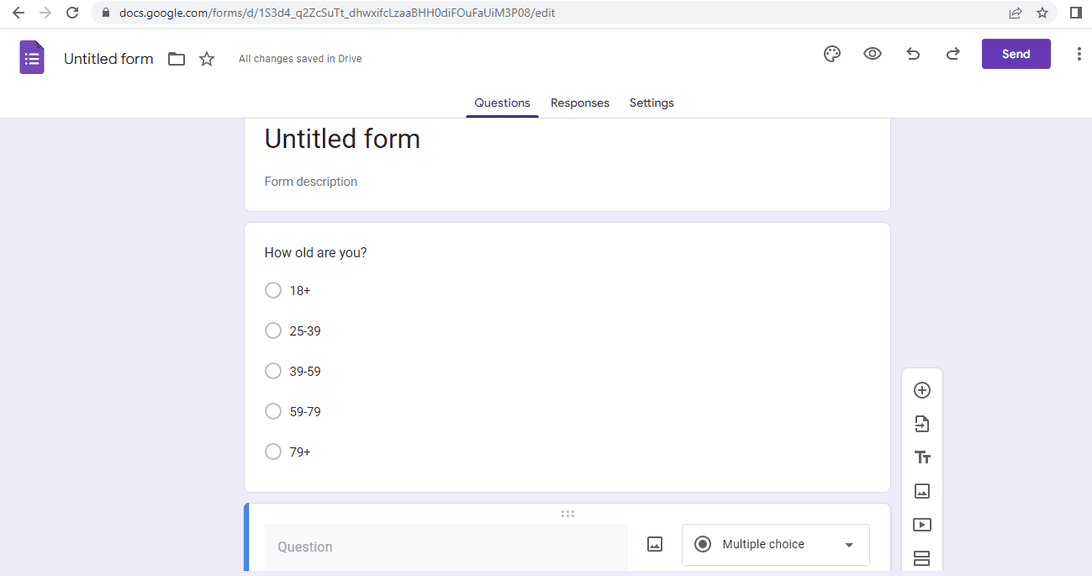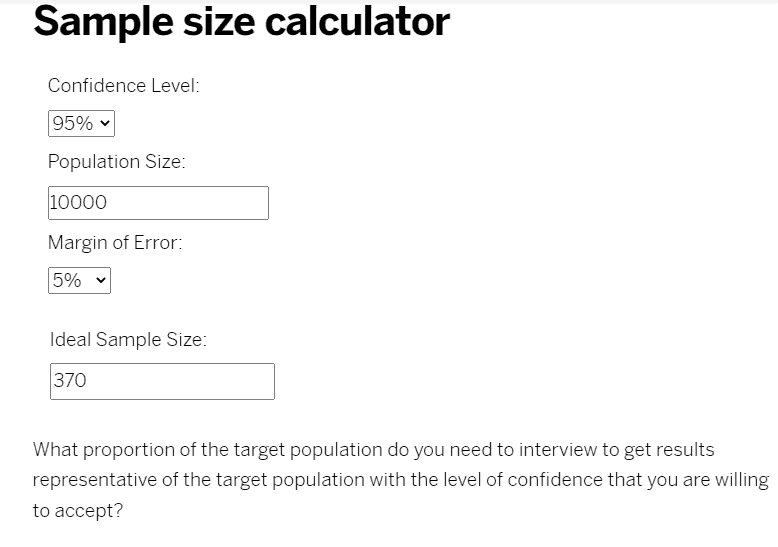Do you want to create a survey to gain insights but don’t know where to start?
The truth is that surveys can be tricky, and others have walked in your proverbial shoes.
Questions such as what tools to use, when to deploy the survey, and how to extract insights from surveys trip people up.
This guide answers your questions and provides tips and best practices to run and deploy surveys that get you actionable insights.
- Frequently Asked Questions
- How to Create a Survey: What You’ll Need
- Step-by-Step Instructions on How to Create a Survey
- STEP 1: Establish Your Survey Goals
- STEP 2: Write Specific Survey Questions
- STEP 3: Examine Survey Questions for Bias
- STEP 4: Create Your Survey
- STEP 5: Determine the Appropriate Sample Size
- STEP 6: Determine Sampling Method
- STEP 7: Determine Delivery Method
- STEP 8: Send Reminders, Where Applicable
- STEP 9: Analyze Survey Responses
- Other Similar Tutorials: How to Create a Survey
- Wrapping Up
Frequently Asked Questions
What is the Easiest Program to Use to Create a Survey Form?
There are many programs to create surveys with, both paid and unpaid services.
That said, one we consider easy to use and free is Google Forms.
However, note that your choice of program is dependent on your needs.
What are the 4 Most Common Survey Types?
If you’re talking in terms of delivery method, the common types of surveys include online, paper, telephonic, and one-to-one interviews.
However, in terms of purpose, the common types of surveys include market surveys, customer experience surveys, product surveys, and brand surveys.
How to Create a Survey: What You’ll Need
To create a survey, these are some of the tools you’ll need:
- Survey Program: Survey programs make it easy to create and analyze surveys. Some of the best survey software include Google Forms, Survey Monkey, and Microsoft Forms. They are mostly useful for online surveys.
- Survey Questions: Whether you’re delivering your survey online or offline, your survey questions need to be specific, contextual, and devoid of words or elements that can induce bias.
- Respondents: You need the RIGHT people to answer your survey questions. Otherwise, the results could be biased or entirely wrong.
Step-by-Step Instructions on How to Create a Survey
You can only draw accurate conclusions from your surveys, if you created the latter on sound methodology.
Sound methodology refers to how you selected your respondents, when and where you get responses, sample size, and much more.
There’s also the issue of eliminating biases such as recency bias from the process.
STEP 1: Establish Your Survey Goals
What do you want to achieve?
This question sets the tone for how you approach your survey project, including the tools and resources you may need, the logistics of running the survey, and the data you need to collect.
For example, if you want to understand the effectiveness of your customer support team, you do not issue surveys to customers who have not interacted with support before.
Furthermore, putting your primary goal into a specific, measurable, relevant, and attainable statement helps you put the same into proper perspective.
For instance, a specific goal could be: “I want to understand if married and single people use our products differently and for different purposes.”
STEP 2: Write Specific Survey Questions
Survey questions cannot be ambiguous.
They have to be specific and clear; respondents must understand the context in which the questions exist.
There are many avenues for mistakes to creep into your survey questions, but these are three of the most common ways.
Avoid Leading Words
Survey questions should not lead or nudge respondents in a particular direction.
For example, using flowery adjectives to describe the subject of a survey question can introduce bias.
Remember, your goal is to elicit objective feedback.
Simple and Clear Answer Choices
In the same vein that the questions have to be specific, choices or answering mechanisms available to respondents must be clear and easy to use.
Imagine the question shown in the image below.
What would your answer be if you were 39?

Avoid Questions With Multiple Interpretations
Avoid questions respondents can interpret in many ways.
“What did you like about our speed of delivery?” is a better question than “What did you like about us?”
Respondents can answer the second question from any angle, including security, parking spaces, and other issues.
While these issues are important, they may not be related to your goal.
STEP 3: Examine Survey Questions for Bias
In terms of questions, we already established why leading questions can induce bias.
In this section, we’ll talk about two other types of biases, including:
- Order bias
- Recall bias.
Order Bias
Findings show that survey respondents are more likely to choose the first answer on the list than other options.
You can mitigate this by randomizing the order of survey answers.
A lot of survey programs can help you achieve this.
Recall Bias
People are more likely to remember the specifics of recent events.
As such, survey questions should try to avoid survey questions that may force respondents to misreport past events or memories.
If you must reference events from the past, make sure the question is short and specific, and the answers are multichoice.
STEP 4: Create Your Survey
Use any of the survey tools to create a survey.
It’s typically intuitive, and the user interfaces are easy to navigate.
For example, this is the interface for Google Forms.

The first time you use Google Forms, you’re taken on a platform tour.
So, there’s no steep learning curve for most tools.
STEP 5: Determine the Appropriate Sample Size
How many people would need to answer your survey for the results to be statistically significant?
Too low, and the results are not representative of the target population.
Too high, and you’ve wasted resources administering the survey to more people than required.
You need to strike the right balance.
You can use sample size calculators to determine the best sample size for your survey project.

Remember, the sample size is not about those to whom you served the survey but those who completed the survey and provided answers to your questions.
STEP 6: Determine Sampling Method
Your sample size should mirror your target population.
There are four practical sampling techniques you can use to select respondents, including:
- Simple random sampling
- Systematic Sampling
- Stratified Sampling
- Cluster Sampling
Simple Random Sampling
Using this method, everyone in the population has an equal probability of being selected.
It’s random and only applicable to small populations.
Systematic Sampling
This sampling method is applicable when you receive members of the population in a series or one by one.
With this method, you select individuals at a predetermined interval and stick with it.
For example, if you’re running a survey in a store, you can survey every fifth person that walks in through the door.
You only have to stick with this rule till the end of the survey project.
Stratified Sampling
This type of sampling is useful when you know the demographics of your population and want to collect data on smaller and larger groups within the overall population.
You can then pick a sample population with the same proportion as the overall population.
For example, if the overall population contains 50 girls and 50 boys, a sample of 10 should have five randomly selected girls and boys each.
Cluster Sampling
This type of sampling is used when the overall population has been divided into identical sub-groups.
You can then use other sampling methods to make a sample from each or any of the groups.
You can equally select one of the groups at random to survey.
STEP 7: Determine Delivery Method
Now that the survey is set and you know who to serve the same to, the next step is to determine the best way to reach them.
Often, the delivery method is self-appointing.
For example, if you created a survey to determine how easy to use your checkout page is, the survey would be delivered online, most likely via email or a pop-up survey.
Other popular delivery methods include:
- QR Codes
- SMS
- Mobile App
- Social Media
One thing to be wary about is ensuring your distribution method factors in the type of population you’re after.
STEP 8: Send Reminders, Where Applicable
If you distributed your survey via email or text messages, you should factor in how you’ll send reminders to your sample population.
STEP 9: Analyze Survey Responses
The last step is to analyze the responses you received.
You should be well-versed in analytics and how to interpret surveys.
Are you aware of statistical tests you can apply to surveys?
While most survey tools have in-built analytics with data such as engagement metrics, having prior knowledge makes it easy to apply and understand the results you’re examining.
Another option is to hire survey companies to ensure you don’t have to worry about this step.
Other Similar Tutorials: How to Create a Survey
The tutorials below are all related to creating a survey and creating an email list to send surveys to.
- How To Create A Poll On Facebook: Do you want to share a quick poll with your Facebook followers, and don’t know where to start? This guide shows you how.
- How To Build An Email List: Having an email list filled with your audience is one of the best online assets you can own. Learn how to build one with this tutorial.
- How to Build an Email List from YouTube: This guide shares creative tips and best practices for building an email list on YouTube. You should check it out.
Wrapping Up
Surveys require a sound methodology to get the best out of them.
The key takeaways you should hold on to include:
- How you ask survey questions matters.
- The answer options and how they’re designed matter.
- The sample size matters and can determine if the conclusions from the survey are statistically significant.




